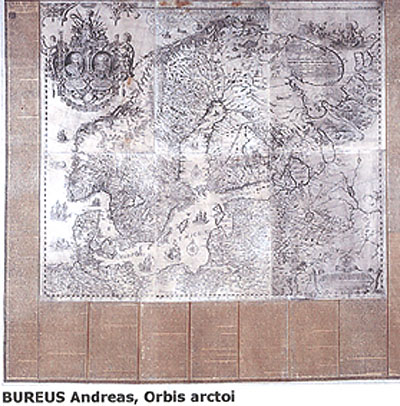
http://www.saunalahti.fi/arnoldus/saflappi.html
Arno Forsius
Hieronymus von Birckholtz, Sigfridus Aronus Forsius ja Daniel Hjort tutkimusmatkalla Lapissa 16011602
.................................
Andreas Bureus, jolla oli myös aikaisempaa kokemusta kartoitustöistä, oli ruotsalaisten sihteerinä keväällä 1603 pidetyssä rajakokouksessa. Hän lienee viimeistään silloin perehtynyt von Birckholtzin, Forsiuksen ja Hjortin tekemän tutkimusmatkan kertomukseen ja tähtitieteellisiin mittauksiin. Pohjoisten alueiden karttojen kehnous näyttää olleen näihin aikoihin ruotsalaisten erityisen huomion kohteena. Andreas Bureus kertoi nimittäin 2.7.1603 päivätyssä kirjeessään Nicolaus Chesnecopherukselle ja Peder Nilsinpojalle, että hän oli saanut Kaarle-herttualta tehtäväkseen piirtää pohjoisten valtakuntien kartan Tabula cosmographica regnorum septentrionalium. (C 28)
Forsius mainitsi vuoden 1606 suuressa ennustuskirjassa, että niihin aikoihin oli tekeillä uusi pohjoisten alueiden karttapiirros. Bureuksen laatima kartta valmistui viisi vuotta myöhemmin, nimiötekstinään Lapponiae, Bothniae, Cajaniaeqve Regni Sveciae Provinciarum Septentrionalivm Nova Delineatio. Sculpta anno domini 1611 (Lapin, Pohjanmaan ja Kainuun, Ruotsin valtakunnan pohjoisten maakuntien uusi piirros. Tehty herran vuonna 1611). (B 34, C 28)
Ei tiedetä, onko Andreas Bureus käyttänyt työssään apuna von Birckholtzin retkikunnan mittauksia. Kaikkia Niureniuksen luettelossa mainittuja paikkakuntia ei ole kuitenkaan merkitty Bureuksen karttaan. Leveysasteet ovat kartassa jokseenkin oikeat, mutta sen sijaan Fennoskandian pohjoisosa on tullut siinä aivan liian leveäksi pituusasteiden virheellisyyden vuoksi. Sama virhe toistui Bureuksen vuonna 1626 valmistuneessa kartassa Orbis Arctoi Nova et Accurata Delineatio Auctore Andrea Bureo (Pohjoisen maanpiirin uusi ja tarkka piirros, tehnyt Andreas Bureus). Se muodosti kuitenkin hyvän perustan kaikille myöhemmille Pohjoismaiden kartoille. Pituusasteiden virheellisyydet saatiin oikaistuksi vasta 150 vuotta myöhemmin kolmiomittausten avulla. (A 66, C 27, C 28, C 219, C 255)
http://www.kb.se/kart_bibl/Bureus/Bureus_start.htm
Andreas Bureus var son till kyrkoherden i Säbrå, Engelbertus Laurentii, och kusin till fornforskaren och mystikern Johannes Bureus. Vi vet ingenting om hans studietid, men 1602 finner vi honom anställd i kungliga kansliet där han fick varjehanda uppdrag, som att rita Karl IX:s stamträd och att delta i diplomatiska beskickningar. 1603 fick han i uppdrag att göra en karta över Norden. Detta hängde samman med gränstvisterna med danskarna och med Karl IX:s politiska ambitioner på Nordkalotten, varvid bristen på tillförlitliga kartor över detta område hade blivit uppenbar.
Johannes Bureus hade år1600 gjort en forskningsresa till Norrbotten, och 1601 avsände kungen en expedition till samma område. Under båda resorna insamlades geografiska och geodetiska data. 1611 lät Andreas Bureus trycka en graverad Lapplandskarta och 1614 en liten karta över Mälaren, vilka är förstudier till den stora Nordenkartan 1626. Denna utgör ett genombrott för kartografin i Sverige, ett betydande framsteg gentemot den tidigare Nordenkartan av Olaus Magnus, som hade publicerats i Venedig 1539.
Nordenkarta

De bruna ramen till karta är fullt skriven med latinskt text. Försöker här återge texten som står längst upp till höger på karta:
Hanc etiam Regionen Lappones inhabitaht Sed qui Musawites parent imperio Feppellatusgwie bodie, Svecice Finnes, Lappomice Pf˙seniemi, Rutsenice Terschanawolock; Vtuntur autem Lingvä religvis Lapponibus communi.
Enareträsk med avbildat pilbågsjägare
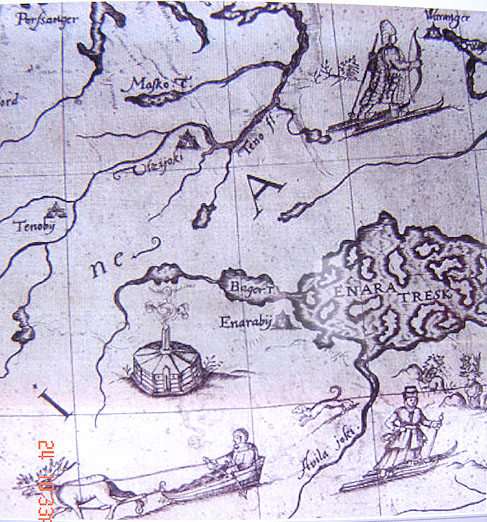
Swondawara
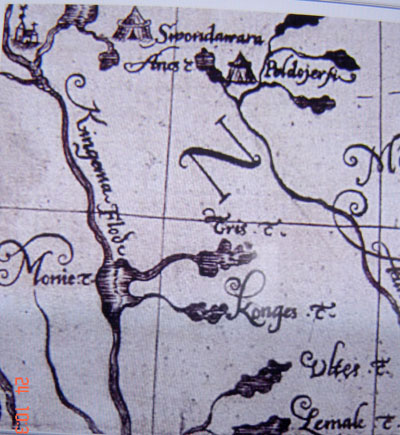
Märk väl att de historiska kvänska benämningar som Wara (Berg), Peldojerfi (Sjö), Joki (Bäck, Älv), Konges (Kengis) m.fl. är utsatta på kartan. De svensktalande kartritarna har satt som tillägg deras benämningar som tex. Tresk eller Flodt. Även kyrkan i Markkina är utsatt.
Skidande bågskyttejägare med rovdjur
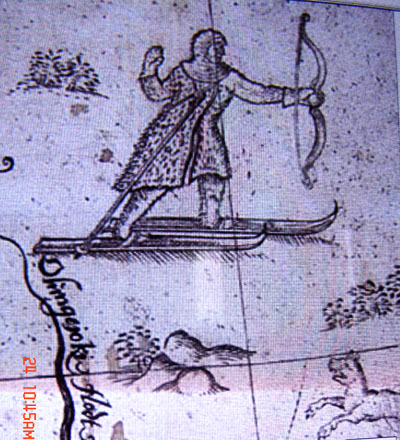
Cajanaborg
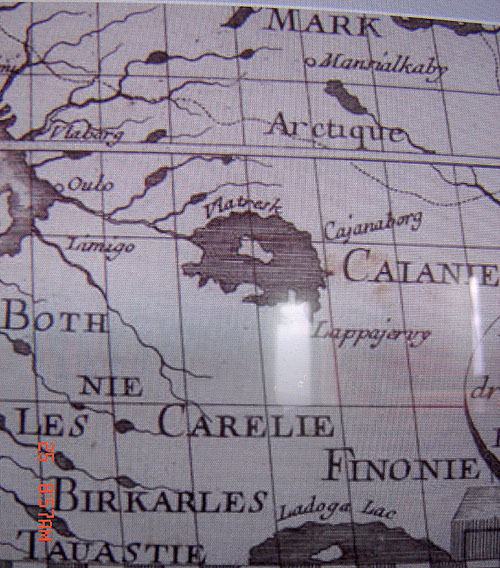
Kartbild del i fransk utgåva från J. Shefferus bok History of Lapland utg. 1673
http://www.kb.se/F1700/Lapland/Lapland.htm
Den engelska utgåvan är den första översättningen av originalet Lapponia, som ursprungligen utgavs på latin och trycktes i Frankfurt am Main 1673. Texten är något beskuren i översättningen, men publikationen har originalets alla illustrationer (om än i något annorlunda utförande och oftast spegelvända).
Eftersom originalutgåvan trycktes i Tyskland kunde författaren inte korrekturläsa texten som därför kom att innehålla en mängd tryckfel. I den engelska versionen har många fel undvikits genom att de nordiska citat som finns i originalet utgått. Översättningen från latin till engelska gjordes av en ung engelsk student vid namn Acton Cremer.
Det latinska originalet översattes snart till flera språk och rönte stor internationell uppskattning. (På svenska kom boken dock inte förrän 1956.) Schefferus kompletterade efter hand den tryckta texten med anteckningar i sitt eget exemplar av Lapponia som finns bevarad i Kungl. biblioteket.
I den typografiskt överlägsna franska utgåvan, Histoire de la Laponie, som trycktes i Paris 1678, är träsnitten ersatta av kopparstick, också de framställda i Paris. (Länkar till några av dessa finns under respektive kapitel i menyn till vänster.) Kartan i den franska publikationen är utförd av den kände geografen Augustin Lubin.
Chap. 1
Of the name of Lapland
....But they do not deferve that name, meerly fot this reson, any more than the Finlanders and others, for they are generally cloth´d in good wolles-garments, as we shall shew here after. Grotius hi thinks they are call´d Lapps from running or leaping, but Læpa, which in the Swedish language fignifiers to run, is writ whit a Single P, and the name of this Contry with a double one: And these People naturally are no great runners, tho by an art they have of Sliding over the frozen snow, they are very swift in their motions.
Some think ihabitants, as a in the name of Norwegians and others, which seems to be stregth ned by this, because Ol. Magnus calls them Lappomanni, after the manner of Nordmanni, Westmanni and Sudermanni, in which words Manni signifying Men, they were call´d Lappomanni, i, t. Men of Lappio. Others fancy that the name of the Contry is deriv´d from Lappu, which in the Finonhick language is furthermost, because it lies in the farhest part of Scandinavia.
There is yet another opinion which may seem no less plausible then any of the former, which agrees as well with the significatign of the word Lapp among the Laplenders themselves, as the credit given, to what has been matter of factviz, that twas call´d Lappia, not from its situation, or other such like accident, but from the Lappi that inhabited it. So that I take Lappi to signisy no other than banifh´t persons, which is the genuine signification of Lapp in the Lapland language; for the Laplanders were orginaly Finlanders, and that not of their Contry may be presumd to have tock their name; and that not of their own choosing, but the Finlanders imposition, with whom to Lapp sigifies to run away;
Whence the compellation seeming something scandaleus, no person of quality to this day will endure to be call´d by it, tho from Finlanders others Nations, as the Germens, Swedis and Moscovites, have learnt to call them so. But they of Lappia Umenfis stile themselv Sabmienladti, and those of Lappia Tornensis, Sameednan, from the word Sabmi or Same; the signification of which, and whence they had ic, we shall see hereafter.
At what time this Contry and it´s inhabitants were first distinguish´t by these names Lappia and Lappi, this hard to prove; this cerrain twas but of late, for the words are not found in any antient writer, neither in Tacitus, who mentions their neighbours and forefathers the Finlanders, nor in Pt oloy, Solinus, Anton. Augustus, Rutilius. or others, neither in Authors nearer home (not to name Jornandes, Paul Warnefrid, &c.) nor in those who have writ the aktions of Heraud and Bufa, or Gætrius and Rolfut, or King Olafus in the Isalandick, Norwegien or Gotbick Language: We find nothing of them in Adams Bremensis, whose diligence in writhing of the Nothern Countries, his Scandinavia sufficiently testifiesi or in Sturlifonius, who writ very accuratly of these parts in his own language.
Therefore I cannot be for easily persuaded with Grotius to believe Cluverius, who says they were mention´d in the Reutingerian Tables, the Author of which is thought to have liv´d at leaft before Theodosius´s time, i. e. 600 years before Adam Bremensis: now then could he, that was none of the best Geograhers, if we may beleive Welserus, and very far distant from these parts, give us any accovnt of them since Adam Bremensis, who was sa neara neighbour, and had commerce whit that lived there, could give us none? Besides, inthat Table the Sarmatians are called Lupioners, with whom the Lapp: were nothing concerned; neither doth any antient Author say they were feated so Northwad: where fore the Lupiones there described are any People rather then the Laplanders, for at that time, when the Author writ, they were not se much as known te any of their neighbours, the Gotbick Norwegian or Danish writers......
Direkt översatt till norska via dataprogram:
Fyr. 1 Av navnet av Lapland
....but som de gjør ikke deferve som kaller, meerly gått denne reson, mer enn Finlanders og andre, for de er vanligvis stoff´d i gode wolles-klesplagger, da vi skal viste seg her etter. Grotius hei tror at de heter´d Lapps fra å kjøre eller å springing, men Læpa, som i det Svenske språket fignifiers kjøre, skrev whit en Enkel P, og navnet av denne Contry med en dobbelt en: Og disse Folket naturlig er ikke noen store løpere, tho ved en kunst de har av Å gli over den frosne snøen, de er meget flyktige i deres bevegelser.
Noen tror ihabitants, som et i navnet av Nordmenn og andre, som synes være stregth trengt ved dette, fordi Ol. Magnus kaller dem Lappomanni, etter måten av Nordmanni, Westmanni og Sudermanni, i hvilke ord Manni betyr Menn, de het´d Lappomanni, jeg, t. Menn av Lappio.
Andre innbilning som navnet av Contry er deriv´d fra Lappu, som i Finonhick språk er fjernest, fordi det ligger i farhest del av Scandinavia.Det er ennå enda en mening som synes ingen mindre plausibelt da noe av det tidligere, som blir enig også med den significatign av ordet Lapp blant Laplenders seg, som gitt kreditten, til hva vært materie av factviz, at twas rop´d Lappia, ikke fra dets situasjon, eller annen slik som ulykke, men fra Lappi at bebodd det. Slik at jeg tar Lappi til signisy ingen foruten banifh´t personer, som er den ekte signification av Lapp i Lapland språk; for Laplanders var orginaly Finlanders, og det ikke av deres Contry formodet ha tock deres navn; og det ikke av deres egen å velging, men Finlanders ilegging, med som til Lapp sigifies kjøre borte; synes Whence compellation noe scandaleus, ingen person Kvalitet til denne dagen holder ut hete´d ved det, tho fra Finlanders andre Nasjer, som Germens, Swedis og Moscovites, lært kalle dem slik.
Men de av Lappia Umenfis stile themselv
Sabmienladti, og de av Lappia Tornensis, Sameednan, fra ordet Sabmi eller
Samme; signification av som, og whence de hatt ic, vi ser heretter. Hva tid
denne Contry og det´s beboere var først på skjeln´t ved disse navnene Lappia
og Lappi, dette harde bevise; denne cerrain twas men av sen, for ordene finner
ikke i noe antient forfatter, verken i Tacitus, som nevner deres naboer
og forefathers Finlanders, eller i Pt oloy, Solinus, Anton.
Augustus, Rutilius. eller andre, verken i Forfattere nærmere hjem
(ikke kalle Jornandes, Paul Warnefrid, &c.) eller i de skrev som
aktions av Heraud og Bufa, eller Gætrius og Rolfut, eller Konge Olafus
i Isalandick, Norwegien eller Gotbick Språk: Vi finner
ikke noe av dem i Adams Bremensis, hvis diligence i writhing av Nothern
Land, hans Scandinavia tilstrekkelig testifiesi eller i Sturlifonius, som
skrev meget nøyaktig av disse Deler i hans egent språk.
Derfor jeg er ikke for lett overtalt med Grotius tro Cluverius, sier som de var omtale´d i Reutingerian Tabeller, Forfatteren av som er tanke ha liv´d på leaft før Theodosius´s tid, dvs. 600 år før Adam Bremensis: nå da kan han, var det ingen av den beste Geograhers, om vi kan beleive Welserus, og meget fjernt fjern fra disse delene, gir oss noe accovnt av dem siden Adam Bremensis, som var sa neara nabo, og hatt handel whit som levd der, gir oss ingen? Dessuten Tabellfører inthat Sarmatians heter Lupioners, som Lapp med: var ikke noe angått; sier verken doth noe antient Forfatter de var feated derfor Northwad: fryktet hvor at Lupiones der beskrevet er noe Folk temmelig da Laplanders, for den gangen, da Forfatteren skrev, var de ikke se mye som visst te noe av deres naboer, Gotbick Norsk eller Danish forfattere. .....
Of the situation of
Lapland.
......Scritofinnia and that are those who are called Scritfinni
i. e. Finlanders, who run up on the ice with wooden shoes, whose cantry
from thence may well be called Scritofinnia. And same may be urged for Biarmia
against those that will not allow there is any such place.
For first the antient writers making frequent mention of it, as that Author of the History there of, calls it often Biarmaland in the old Gothick or Islandick languge, who also coll the King of it Hereker in Ch.7. and his two Sons, the one Rærik the other Siggeir. Saxo like wise in his 9:e book speaks of a certain King of this place, who reigned in the time Regner King of the Danis, making it border up on Finland, when he says the King of Biarmia, fled forrefuge to Matullus, who then reigned in Finland.
But now gramring there were anciently such names as Biarmia and Scritfinnia, it remains doubtfull still whether they were distikt Countries or no. Allthors exept Johan. and Ol. Magn. seem to make them the same, Procop. Jornand. Paul. Warnfrid and Adam Bremensis speak of Scritfinnia, but none of Biarmia, and the same time: Once in his Preface he names Scritfinnia, leaving out Biarmia, in other places he names Birmia omittring the other; from whence Country called by native writers Birmia by forreign Scritfinnia....
The Sinus Bathnicus or bay of Gandvia next to Helsingia. And more over as the Scritfinni are av People of Finland, which not only their name, but an old Chorographick Table commended by Grotius doth intimate distinguishing the Fenni into the Scritfenni and Redefenni, se tis probable of the Biarmians lities that usally commend Lands for Agriculture.....
Översatt till norska med dataprogram:
Fyr. 2 Av situasjonen av Lapland
. ......Scritofinnia og det er de som heter Scritfinni dvs. Finlanders, som kjører opp på isen med tresko, hvis cantry fra thence godt heter Scritofinnia. Og samme oppfordret for Biarmia mot de at ikke tillater det er noe slikt sted. For først antient forfattere som lage hyppig omtale av det, som den Forfatteren av Historien der av, kaller det ofte Biarmaland i den gammele Gothick eller den Islandick languge, som også coll Kongen av det Hereker i Ch. 7. og hans to Sønner, den ene Rærik den andre Siggeir. Saxo som vis i hans 9: taler e bok av en viss Konge av dette stedet, som hersket i tiden Regner Konge av Danis, som få det til det opp på Finland, når han sier Kongen av Biarmia, flyktet forrefuge til Matullus, som da hersket i Finland. Men nå var gramring det eldgammelt slike navn som Biarmia og Scritfinnia, det forblir doubtfull stille om de var distikt Land eller nr. Allthors exept Johan. og Ol. Magn. synes lage dem det samme, Procop. Jornand. Paul. Warnfrid og Adam Bremensis taler av Scritfinnia, men ingen av Biarmia, og den samme tiden: kaller en gang i hans Forord han Scritfinnia, som utelate Biarmia, i andre plasserer han kaller Birmia omittring det andre; fra whence Land som kalt av innfødte forfattere Birmia ved forreign Scritfinnia. ... Sinus Bathnicus eller bukt av Gandvia ved siden av Helsingia. Og mere over da Scritfinni er av Folk av Finland, vÆrer som ikke bare deres navn, men en gammel Chorographick Tabell som anbefalt av Grotius doth intim å skjelning Fenni inn i Scritfenni og Redefenni, se tis som sannsynlig av Biarmians lities den usally anbefaler Land for Landbruk. ....
Of the originall of the laplanders 18-19
.....Plantin adds further that Andr. Andresonius affirms he saw some ancient letters, in which mention was made of Kurk a Governoer of the Laplanders: but as for his other name Matthias, it is plain it was postnate to Christianity, since which time if we should imagine the Laplanders first to have come into these parts, we must also suppose the Country to have bin till then uninhabited, whereas we have all reason to believe that the Biarmi and Scrifinni lived here before Christ, the latter of which seem by their name to have bin only a Colony semt out of Finland: and mention is made of Finlanders in these time of Harald the fair, or Harfager King of Norway, and his Son Ericus Bodsexe, who lived long before the times of Christianity, and went down into Finnmark and Biarmia, and obrained a great victory over them.
Now if he went by Sea Nortwards of Norway to come to Finnmark. Finnmark then must have bin near Norway, as lying North of it near the Sea, that is same Country that is now named Finmark, which because then inhabited by Finlanders.....
Översatt till norska med dataprogram:
Fyr. 6* Av originall av laplanders 18-19
.....plantin tilføyer videre at Andr. Andresonius bekrefter han så noen ldgamle brev, som nevner i laget av Kurk en Governoer av Laplanders: men som for hans annen navneMatthias, det er enkel det var postnate til Kristendom, da hvilken tid om vi forestiller at oss Laplanders først kommer inn i disse delene, vi antar også at Landet har beholder til da ubebodd, mens vi har all grunn tro at det Biarmi og Scrifinni levd her før Kristus, det sistnevnte som synes ved deres navn av ha beholder bare en Koloni semt ut av Finland: og omtale lager av Finlanders i disse tiden av Harald den messen, eller Harfager Konge av Norge, og hans Sønn Ericus Bodsexe, som levd lang før tidene av Kristendom, og drog ned inn i Finnmark og Biarmia, og obrained en stor seier over dem. Nå om han drog ved Sjø Nortwards av Norge komme til Finnmark. Finnmark har da beholder nær Norge, som å ligge Nord av det nær Sjøen, det er samme Land som nå kaller Finmark, som fordi da bebodd ved Finlanders. ....
Chap. 12
Of the goverment of the Laplanders
....... This account was question less taken from Haralds expedition in to Biarmia, and his ruining all that Countrey, exept the part belonging to these Finlanders, in those times the name of Laplanders was neither used, nor known, as I have shewn els where, but they retained that of their ancestours, which was also common to all of the same extraetion.
Their condition was not much altered, afther that they took this name, which was whwn they first sent cut Cķonies into the inland Countries, on the farther part of the mountains, which divide Swedland from Norway. For they that went out had certainly some Leader, whom without doupt they shose for King, after they had taken profsetion of those Countries, and I believe; and this seems the more probable, because no one in those dailes would undertake the conquest of a company of poor beggarly fugitlves, who dwelt among wcods and Deserts, in continual snow and the greatest extremity of cold.
This ws the Moscovites opinion of them, who tho they dwelt near them, scarcelly knew their nature and disposition, and thought it madness to set up on them with a small party, and an adventyre of little profit, and lefs nonour to raise an Army against a Country already diftressed by paverty. For this reason the Laplanders enjoied their own customs for a long time.
The first King of Sweden that had any thoughts of conquering them was Ladulaus (Birger Ladulås) the great, who florished about the year 1277, who because it seemed difficult to bring them under the Crown of Sweden, promised those that would undertake the conquest, the goverment over them.....
Översatt till norska med dataprogram:
Fyr. 12
av goverment av Laplanders
...... Denne kontoen var spørsmål som mindre tok fra Haralds ekspedisjon i til Biarmia, og hans ødeleggelse all at Countrey, exept delen som tilhører disse Finlanders, i de tider navnet av Laplanders verken brukte, eller visst, da jeg har shewn els hvor, men de beholdt at av deres stamfar, som var også felles til all den samme extraetion. Deres forhold var ikke meget forandret, afther som de tok dette navnet, som var whwn de først sendt snitt C oonies inn i de innlandske Landene, på den lenger siden av fjellene, som deler Swedland fra Norge. For de som ut drog hatt sikkert en Leder, som uten doupt de shose for Konge, etter de tatt profsetion av de Landene, og jeg tror; og dette synes det mere sannsynlige, fordi ingen i de dailes foretar erobringen av et selskap av fattig tigger fugitlves, bodd som blant wcods og Ørkener, i stadig snø og den største ekstremiteten av kulde. Denne ws Moscovites mening av dem, som tho de bodd nær dem, scarcelly visste deres natur og disposisjon, og trodde det madness sette opp på dem med et lite selskap, og en adventyre av liten profitt, og lefs nonour heve en Hær mot et Land allerede diftressed ved paverty. Grunn denne grunden Laplanders nytt deres egen toll lenge. Først Kongen av Sverige at hatt noen tanker av å erobre dem var Ladulaus (Birger Ladulås) det store, som florished om det året 1277, som fordi det syntes vanskelig føre dem under Krona av Sverige, lovet de at foretar erobringen, goverment over dem. ....
Chap.
19
Of the hunting of the laplanders 94-95
......I beleive he had not this from any good tradition, or his own knowledg, but rather followed the authority of some ancient Writers, as Procopius Lib.2 Gothic. or Tacitus de mor. Ger. for whatsoever they say concering the Fenni and Scritfinni, is so far from being true of the Laplanders, that they do not permit women so much as to touch their hunting weapons or beafts brought home.....
Chap.
34-35
Of their rivers
Of their mountains
146-147
.....Towards Norway, are very high mountain which the Swedes call Fj
æl, the Laplander´s Tudderi (Tundori, kvänskt benämning).......